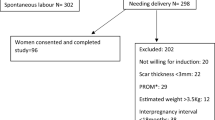Abstract
Objective
To report complications associated with the use of trans-cervical Foley catheter with extra-amniotic saline infusion (EASI) for cervical ripening.
Methods
This is a retrospective descriptive study of 1,083 women who underwent EASI ripening. Data on perinatal outcome was retrieved from our computerized database and the medical charts. The primary study outcome was the occurrence of side effects related to the procedure.
Results
The study population included 1,083 women. The balloon had to be removed due to complications in 95 (8.8%). The main complications were: acute transient febrile reaction in 32 (3%), non-reassuring fetal heart rate tracing in 22 (2%), vaginal bleeding in 20 (1.8%), unbearable pain that necessitated removal of the catheter in 19 women (1.7%) and altered presentation from vertex to breech in 14 (1.3%).
Conclusion
Complications associated with trans-cervical ripening and EASI occurred in 7.6% and included acute febrile reaction, pain, vaginal bleeding and altered fetal presentation.
Similar content being viewed by others
References
Martin JA, Hamilton BE, Sutton PD, Ventura SJ, Menacker F, Kirmeyer S (2006) Births: final data for 2004. Natl Vital Stat Rep 55:1–101
Hemlin J, Moller B (1998) Extraamniotic saline infusion is promising in preparing the cervix for induction of labor. Acta Obstet Gynecol Scand 77(1):45–49. doi:10.1080/00016349808565810
Sherman DJ, Frenkel E, Tovbin J, Arieli S, Caspi E, Bukovsky I (1996) Ripening of the unfavorable cervix with extraamniotic catheter balloon: clinical experience and review. Obstet Gynecol Surv 51(10):621–627. doi:10.1097/00006254-199610000-00022
Guinn DA, Davies JK, Jones RO, Sullivan L, Wolf D (2004) Labor induction in women with an unfavorable Bishop score: randomized controlled trial of intrauterine Foley catheter with concurrent oxytocin infusion versus Foley catheter with extra-amniotic saline infusion with concurrent oxytocin infusion. Am J Obstet Gynecol 191(1):225–229. doi:10.1016/j.ajog.2003.12.039
Lin MG, Reid KJ, Treaster MR, Nuthalapaty FS, Ramsey PS, Lu GC (2007) Transcervical Foley catheter with and without extraamniotic saline infusion for labor induction: a randomized controlled trial. Obstet Gynecol 110(3):558–565
Karjane NW, Brock EL, Walsh SW (2006) Induction of labor using a Foley balloon, with and without extra-amniotic saline infusion. Obstet Gynecol 107(2 Pt 1):234–239
Siddiqui S, Zuberi NF, Zafar A, Qureshi RN (2003) Increased risk of cervical canal infections with intracervical Foley catheter. J Coll Physicians Surg Pak 13(3):146–149
Lin A, Kupferminc M, Dooley SL (1995) A randomized trial of extra-amniotic saline infusion versus laminaria for cervical ripening. Obstet Gynecol 86(4 Pt 1):545–549
Goldman JB, Wigton TR (1999) A randomized comparison of extra-amniotic saline infusion and intracervical dinoprostone gel for cervical ripening. Obstet Gynecol 93(2):271–274. doi:10.1016/S0029-7844(98)00359-7
Guinn DA, Goepfert AR, Christine M, Owen J, Hauth JC (2000) Extra-amniotic saline, laminaria, or prostaglandin E(2) gel for labor induction with unfavorable cervix: a randomized controlled trial. Obstet Gynecol 96(1):106–112. doi:10.1016/S0029-7844(00)00856-5
Embrey MP, Mollison BG (1967) The unfavourable cervix and induction of labour using a cervical balloon. J Obstet Gynaecol Br Commonw 74(1):44–48
Lieberman JR, Piura B, Chaim W et al (1977) The cervical balloon method for induction of labor. Acta Obstet Gynecol Scand 56:499
Ezimokhai M, Nwabineli JN (1980) The use of Foley catheter in ripening the unfavorable cervix before induction of labor. Br J Obstet Gynaecol 87:281
Jagani M, Schulman H, Fleisher A et al (1982) Role of the cervix in the induction of labor. Obstet Gynecol 59:21
Culver J, Strauss RA, Brody S, Dorman K, Timlin S, McMahon MJ (2004) A randomized trial comparing vaginal misoprostol versus Foley catheter with concurrent oxytocin for labor induction in nulliparous women. Obstet Gynecol Surv 59(12):811–813. doi:10.1097/01.ogx.0000141204.29931.9b
Abramovici D, Goldwasser S, Mabie BC, Mercer BM, Goldwasser R, Sibai BM (1999) A randomized comparison of oral misoprostol versus Foley catheter and oxytocin for induction of labor at term. Am J Obstet Gynecol 181(5 Pt 1):1108–1112. doi:10.1016/S0002-9378(99)70090-6
Maslovitz S (2004) Conversion from vertex to breech after extra-amniotic saline installation. Obstet Gynecol 103(6):1341
Author information
Authors and Affiliations
Corresponding author
Rights and permissions
About this article
Cite this article
Maslovitz, S., Lessing, J.B. & Many, A. Complications of trans-cervical Foley catheter for labor induction among 1,083 women. Arch Gynecol Obstet 281, 473–477 (2010). https://doi.org/10.1007/s00404-009-1136-7
Received:
Accepted:
Published:
Issue Date:
DOI: https://doi.org/10.1007/s00404-009-1136-7




